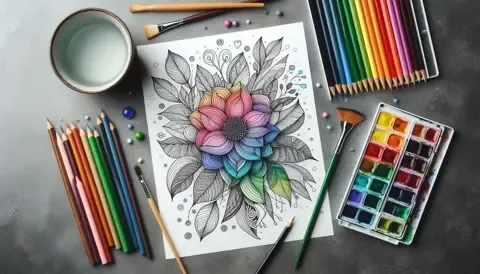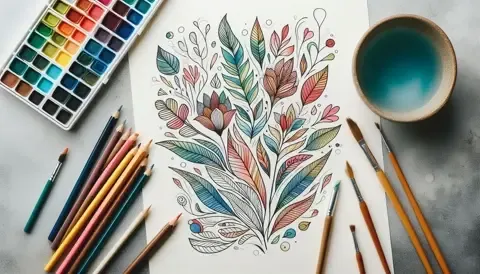How to Use Watercolor Pencils for Stunning Effects
Unlocking the Magic of Watercolor Pencils: Tips, Techniques, and Creative Inspiration
Introduction
Watercolor pencils are a versatile and exciting medium that combine the control of colored pencils with the fluid beauty of watercolors. Whether you are a beginner or an experienced artist, mastering watercolor pencils can open up new creative possibilities.
With their portability, ease of use, and ability to create both detailed and painterly effects, watercolor pencils are an excellent tool for any artist. This guide will walk you through the essential techniques, tools, and tips for achieving stunning effects with watercolor pencils and taking your art to the next level.
1. Understanding Watercolor Pencils
Watercolor pencils look like regular colored pencils but have a water-soluble pigment. When water is applied, the pigments dissolve and blend, creating soft, watercolor-like washes. They are ideal for adding fine details, creating smooth gradients, and experimenting with new artistic styles.
Watercolor pencils can be used for a variety of artistic applications, from sketching and fine art to journaling, crafting, and mixed media projects. Their portability and ease of use make them a favorite among artists of all levels, offering the perfect blend of control and creativity.
2. Essential Supplies
To get started with watercolor pencils, you will need:
2.1 Watercolor Pencils
Choose high-quality watercolor pencils for vibrant colors and smooth blending. Popular brands include Faber-Castell, Derwent, and Prismacolor. Consider getting a range of colors to provide versatility in shading and blending. Investing in artist-grade pencils ensures richer pigmentation and more consistent results, while student-grade options are great for beginners exploring the medium.
2.2 Watercolor Paper
Use watercolor paper with a weight of at least 140 lb (300 gsm) to prevent warping and ensure better water absorption. Cold-pressed paper offers texture for a more painterly effect, while hot-pressed paper provides a smoother surface for finer details. Experiment with different textures to see which works best for your style and desired effects.
2.3 Brushes
Opt for soft brushes, such as round or flat watercolor brushes, to control the flow of water. Synthetic brushes can be easier to control for beginners, while natural hair brushes provide excellent water retention. A small variety of brush sizes will give you the flexibility to work on both fine details and larger washes.
2.4 Water and Containers
Keep two water containers: one for rinsing brushes and another for clean water to activate colors. Having an extra container ensures that your colors remain bright and uncontaminated. Consider using a spray bottle to lightly mist your paper for controlled water application.
2.5 Blending Tools
You can use blending stumps, cotton swabs, or your fingers to achieve different blending effects. Experiment with sponges and tissues for unique textures and finishes. Palette knives and even toothbrushes can also be used for creative texturing.
3. Basic Techniques
Mastering the fundamental techniques will help you achieve a variety of effects with watercolor pencils.
3.1 Dry Application and Blending
- Apply watercolor pencils directly to dry paper for precise control.
- Blend colors using a dry brush, blending tool, or your fingers for smooth transitions.
- Use shading techniques to create gradients and depth in your artwork.
- Layer colors gradually to add richness and complexity, avoiding over-saturation in a single layer.
3.2 Wet Application
- Dampen your paper lightly before applying the pencils for softer, diffused edges.
- Create seamless blending and smoother transitions by layering colors over wet paper.
- Experiment with layering colors to build intensity and explore different textures.
- Use wet-on-wet techniques to create atmospheric effects like mist, clouds, or water reflections.
3.3 Drawing and Activating with Water
- Sketch your design with watercolor pencils, keeping lines light for a natural look.
- Use a wet brush to activate and spread the pigment, creating a watercolor effect.
- Control the amount of water for different effects, from light washes to bold color saturation.
- Practice controlled washes to achieve professional, polished finishes.
3.4 Lifting and Erasing
- Use a damp cloth or sponge to lift color and create highlights or corrections.
- A kneaded eraser can be used to lighten areas before adding water.
- Experiment with lifting techniques to add texture and dynamic contrast to your artwork.
3.5 Layering Colors
- Apply multiple layers of color, allowing each layer to dry completely before adding more.
- Layering adds depth and richness, making your artwork more vibrant and realistic.
- Experiment with varying pressure and pencil angles to achieve different opacities and textures.
4. Advanced Techniques
Once you are comfortable with basic methods, try these advanced techniques to create more complex effects.
4.1 Glazing
- Apply a transparent wash of color over a dried layer to create luminous effects.
- Use this technique to adjust color intensity, add dimension, and create a glowing effect.
- Experiment with warm and cool color glazes to enhance depth and mood in your compositions.
4.2 Negative Painting
- Leave areas of white paper untouched to create highlights and striking contrast.
- Build layers around the highlighted areas for added depth and complexity.
- Use masking fluid or tape to preserve intricate details and create negative space effects.
4.3 Mixed Media Approaches
- Combine watercolor pencils with traditional watercolors, ink, or pastels for mixed-media effects.
- Use watercolor pencils to add fine details, outlines, or subtle enhancements to watercolor paintings.
- Experiment with combining pencils and pen-and-ink techniques for bold, graphic compositions.
4.4 Dry Brush Technique
- Use a slightly damp brush to pick up pigment directly from the pencil tip for intense color application.
- Apply it to dry paper for bold, textured, and controlled strokes.
- This technique is ideal for adding texture, fine details, and accents to your artwork.
5. Common Mistakes to Avoid
Avoiding these common mistakes will help you achieve better results:
Using too much water: Excess water can cause colors to bleed uncontrollably and paper to warp. Apply water sparingly and build layers gradually.
Skipping paper preparation: Always use quality paper and tape it down to avoid buckling and ensure a smoother finish.
Not layering properly: Rushing layering can result in muddy colors and a lack of vibrancy. Take your time to build colors gradually.
Overworking the paper: Too much scrubbing or reworking can damage the surface, leading to uneven textures. Work gently and deliberately.
Ignoring brush quality: Cheap brushes may not hold water well, leading to streaky or uneven washes. Invest in reliable brushes for consistent results.
6. Creative Project Ideas
To put your skills to the test, try these fun projects:
6.1 Floral Illustrations
Create delicate flowers using layering and blending techniques. Focus on realistic shading, soft transitions, and the intricate details of petals and leaves.
6.2 Landscape Scenes
Experiment with washes to capture dynamic skies, serene mountains, and reflective waters. Try adding atmospheric effects like mist, fog, or dappled sunlight for added drama.
6.3 Portraits
Use fine lines and subtle color blending to achieve realistic skin tones and expressions. Focus on light and shadow to add depth and bring your subject to life.
6.4 Greeting Cards
Design personalized watercolor-style greeting cards with beautiful effects. Experiment with calligraphy, decorative borders, and thematic illustrations.
6.5 Animal Studies
Practice capturing textures like fur, feathers, and scales. Pay attention to the play of light and shadow to make your animal subjects more lifelike and expressive.
7. Tips for Success
- Work in layers to build colors gradually and avoid overwhelming your composition.
- Test color combinations and techniques on scrap paper before applying them to your final piece.
- Keep brushes and tools clean to avoid unintended color mixing or muddy effects.
- Experiment with different water-to-pigment ratios to discover unique textures and effects.
- Practice regularly and challenge yourself with new techniques to develop your unique artistic style.
- Invest in high-quality materials to enhance your experience and achieve professional results.
Conclusion
Watercolor pencils offer a unique and accessible way to explore watercolor techniques with added control and precision. Whether you're creating delicate washes, vibrant details, or bold designs, mastering these pencils can elevate your artwork to new heights.
Start practicing today, and let your creativity flow as you discover the endless possibilities watercolor pencils have to offer!










0 comments